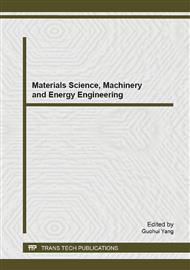[1]
Franck Betin, Daniel Pinchon, and Gérard-André Capolino Fuzzy Logic Applied to Speed Control of a Stepping Motor Drive[J]. IEEE Transactions on Industrial Electronics, 2000, 47(3): 610-622.
DOI: 10.1109/41.847902
Google Scholar
[2]
Ki-Chae Lim, Jung-Pyo Hong, Gyu-Tak Kim, Characteristic Analysis of 5-phase Hybrid Stepping Motor Considering the Saturation of Both Teeth and Poles[J]. Industry Applications Conference, 2000. Conference Record of the 2000 IEEE Volume 1, 8-12 Oct. 2000 Page(s): 132 - 138.
DOI: 10.1109/ias.2000.881041
Google Scholar
[3]
J.D. Wale and C. Pollock, Hybrid stepping motors and drives[J], POWER ENGINEERING JOURNAL FEBRUARY, 2001.
Google Scholar
[4]
Sheng-ming Yang,Ei-lang Kuo. Damping a Hybrid Stepping Motor With Estimated Position and Velocity[J]. IEEE Trans. on Power Electronics,2008,(3):880-887.
DOI: 10.1109/tpel.2003.810836
Google Scholar
[5]
S A Schweid,J E McInroy,R M Lofthus. Closed Loop Low-velocity Regulation of Hybrid Stepping Motors Amidst Torque Disturbances[J]. IEEE Trans. Ind. Electron. ,1995,42: 316-324.
DOI: 10.1109/41.382143
Google Scholar
[6]
M. Bodson,J. Chiasson R.T. Novotnak, and R.B. Rekowski. High performance nonlinear feedback control of a permanent magnet stepper motor [J], IEEE Trans. Control System. Technology., 1993, 1:5–13.
DOI: 10.1109/87.221347
Google Scholar
[7]
J. Lee, On Methods for Improving Performance of PI-type Fuzzy Logic Controllers[J], IEEE Trans. Fuzzy Syst., 1993, 1:298-30 1.
DOI: 10.1109/91.251930
Google Scholar
[8]
F. Betin,D. Pinchon, and G. -A. Capolino, Fuzzy logic applied to speed control of steeping motor drive[J], IEEE Trans. Ind. Electron., 2000, 47:610–622.
DOI: 10.1109/41.847902
Google Scholar
[9]
Ahmed Rubaai,Marcel J. Castro-Sitiriche,Moses Garuba,Legand Burge Implementation of Artificial Neural Network-Based Tracking Controller for High-Performance Stepper Motor Drives [J]. IEEE Trans. on Ind. Electron., 2007, 54:218-226.
DOI: 10.1109/tie.2006.888785
Google Scholar
[10]
H.D. Patino and D. Liu, Neural network-based model reference adaptive control system[J], IEEE Trans. System., Man. Cybern. B, Cybern., 2000, 30:198–204.
DOI: 10.1109/3477.826961
Google Scholar
[11]
Miura,T., Taniguchi,T. Open-loop Control of a Stepping Motor Using Oscillation-suppressive Exciting Sequence Tuned by Genetic Algorithm[J]. IEEE Trans. Industry Electron, 1999, 46 (6): 1192-1198.
DOI: 10.1109/41.808009
Google Scholar
[12]
Csaba SZASZ, Fuzzy Strategy-based Position Control of Field-oriented PM-hybrid Stepping Motor, [J]. IEEE Conference on Fuzzy system, 2007: 1-5 , North American.
DOI: 10.1109/fuzzy.2007.4295494
Google Scholar
[13]
Zheng Xueqin,Guo Donghui. Study on Driving Control of Two-phase Stepping Motor Based on Mixing Mode PWM[J] Journal of System Simulation, 2012, 24(2): 456-461.
Google Scholar
[14]
T. Yang, Architectures of Computational verb controllers: Towards a New Paradigm of Intelligent Control[J], International Journal of Computational Cognition, Vol. 3, No. 2, June (2005).
Google Scholar
[15]
T. Yang, Simple Computational Verb PID Controllers[J], International Journal of Computational Cognition, Vol. 7, No. 1, March 2009, pp.
Google Scholar


